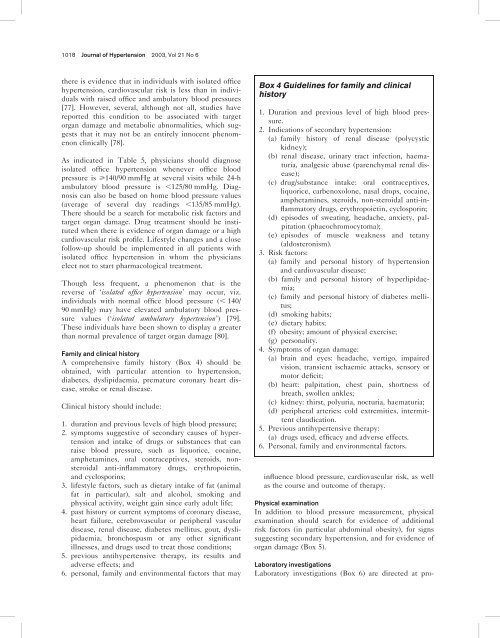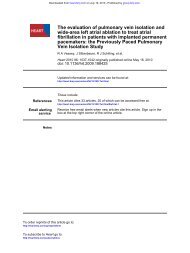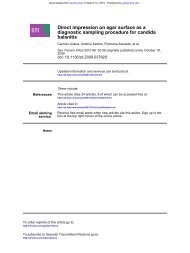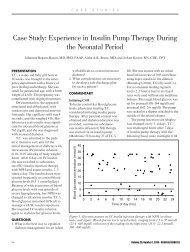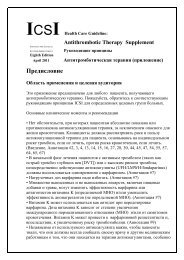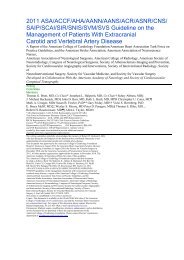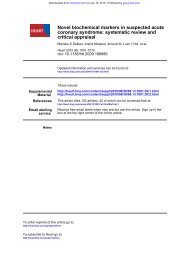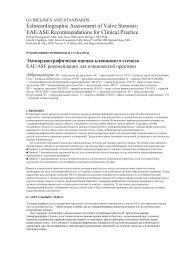ESH, ESC Guidelines for Arterial Hypertension Management 2003
ESH, ESC Guidelines for Arterial Hypertension Management 2003
ESH, ESC Guidelines for Arterial Hypertension Management 2003
Create successful ePaper yourself
Turn your PDF publications into a flip-book with our unique Google optimized e-Paper software.
1018 Journal of <strong>Hypertension</strong> <strong>2003</strong>, Vol 21 No 6<br />
there is evidence that in individuals with isolated office<br />
hypertension, cardiovascular risk is less than in individuals<br />
with raised office and ambulatory blood pressures<br />
[77]. However, several, although not all, studies have<br />
reported this condition to be associated with target<br />
organ damage and metabolic abnormalities, which suggests<br />
that it may not be an entirely innocent phenomenon<br />
clinically [78].<br />
As indicated in Table 5, physicians should diagnose<br />
isolated office hypertension whenever office blood<br />
pressure is >140/90 mmHg at several visits while 24-h<br />
ambulatory blood pressure is ,125/80 mmHg. Diagnosis<br />
can also be based on home blood pressure values<br />
(average of several day readings ,135/85 mmHg).<br />
There should be a search <strong>for</strong> metabolic risk factors and<br />
target organ damage. Drug treatment should be instituted<br />
when there is evidence of organ damage or a high<br />
cardiovascular risk profile. Lifestyle changes and a close<br />
follow-up should be implemented in all patients with<br />
isolated office hypertension in whom the physicians<br />
elect not to start pharmacological treatment.<br />
Though less frequent, a phenomenon that is the<br />
reverse of ‘isolated office hypertension’ may occur, viz.<br />
individuals with normal office blood pressure (, 140/<br />
90 mmHg) may have elevated ambulatory blood pressure<br />
values (‘isolated ambulatory hypertension’) [79].<br />
These individuals have been shown to display a greater<br />
than normal prevalence of target organ damage [80].<br />
Family and clinical history<br />
A comprehensive family history (Box 4) should be<br />
obtained, with particular attention to hypertension,<br />
diabetes, dyslipidaemia, premature coronary heart disease,<br />
stroke or renal disease.<br />
Clinical history should include:<br />
1. duration and previous levels of high blood pressure;<br />
2. symptoms suggestive of secondary causes of hypertension<br />
and intake of drugs or substances that can<br />
raise blood pressure, such as liquorice, cocaine,<br />
amphetamines, oral contraceptives, steroids, nonsteroidal<br />
anti-inflammatory drugs, erythropoietin,<br />
and cyclosporins;<br />
3. lifestyle factors, such as dietary intake of fat (animal<br />
fat in particular), salt and alcohol, smoking and<br />
physical activity, weight gain since early adult life;<br />
4. past history or current symptoms of coronary disease,<br />
heart failure, cerebrovascular or peripheral vascular<br />
disease, renal disease, diabetes mellitus, gout, dyslipidaemia,<br />
bronchospasm or any other significant<br />
illnesses, and drugs used to treat those conditions;<br />
5. previous antihypertensive therapy, its results and<br />
adverse effects; and<br />
6. personal, family and environmental factors that may<br />
Box 4 <strong>Guidelines</strong> <strong>for</strong> family and clinical<br />
history<br />
1. Duration and previous level of high blood pressure.<br />
2. Indications of secondary hypertension:<br />
(a) family history of renal disease (polycystic<br />
kidney);<br />
(b) renal disease, urinary tract infection, haematuria,<br />
analgesic abuse (parenchymal renal disease);<br />
(c) drug/substance intake: oral contraceptives,<br />
liquorice, carbenoxolone, nasal drops, cocaine,<br />
amphetamines, steroids, non-steroidal anti-inflammatory<br />
drugs, erythropoietin, cyclosporin;<br />
(d) episodes of sweating, headache, anxiety, palpitation<br />
(phaeochromocytoma);<br />
(e) episodes of muscle weakness and tetany<br />
(aldosteronism).<br />
3. Risk factors:<br />
(a) family and personal history of hypertension<br />
and cardiovascular disease;<br />
(b) family and personal history of hyperlipidaemia;<br />
(c) family and personal history of diabetes mellitus;<br />
(d) smoking habits;<br />
(e) dietary habits;<br />
(f) obesity; amount of physical exercise;<br />
(g) personality.<br />
4. Symptoms of organ damage:<br />
(a) brain and eyes: headache, vertigo, impaired<br />
vision, transient ischaemic attacks, sensory or<br />
motor deficit;<br />
(b) heart: palpitation, chest pain, shortness of<br />
breath, swollen ankles;<br />
(c) kidney: thirst, polyuria, nocturia, haematuria;<br />
(d) peripheral arteries: cold extremities, intermittent<br />
claudication.<br />
5. Previous antihypertensive therapy:<br />
(a) drugs used, efficacy and adverse effects.<br />
6. Personal, family and environmental factors.<br />
influence blood pressure, cardiovascular risk, as well<br />
as the course and outcome of therapy.<br />
Physical examination<br />
In addition to blood pressure measurement, physical<br />
examination should search <strong>for</strong> evidence of additional<br />
risk factors (in particular abdominal obesity), <strong>for</strong> signs<br />
suggesting secondary hypertension, and <strong>for</strong> evidence of<br />
organ damage (Box 5).<br />
Laboratory investigations<br />
Laboratory investigations (Box 6) are directed at pro-


